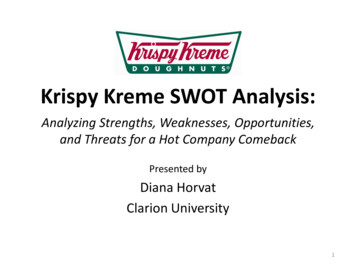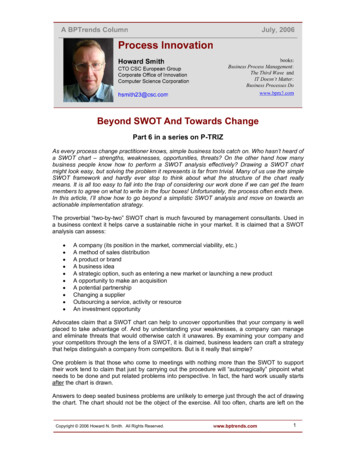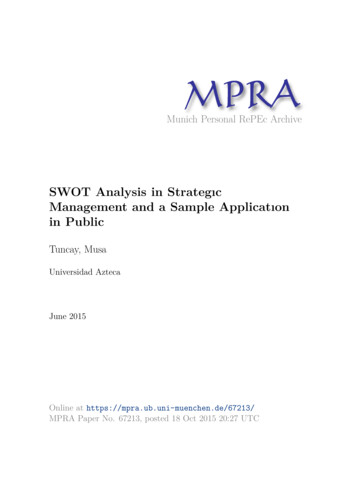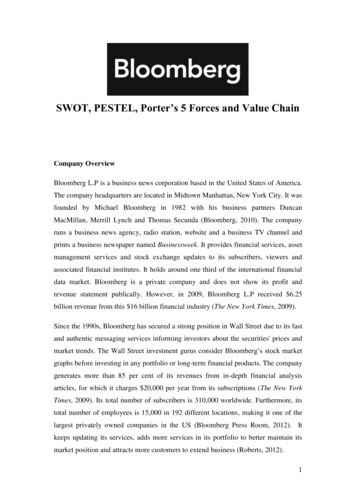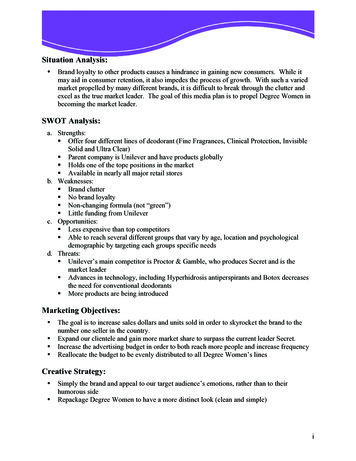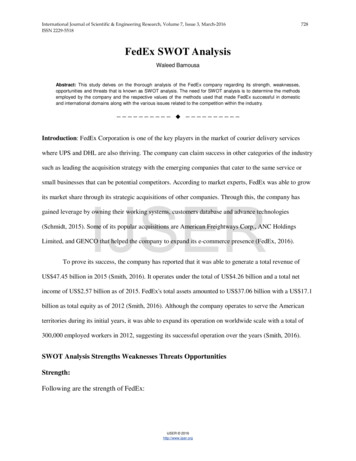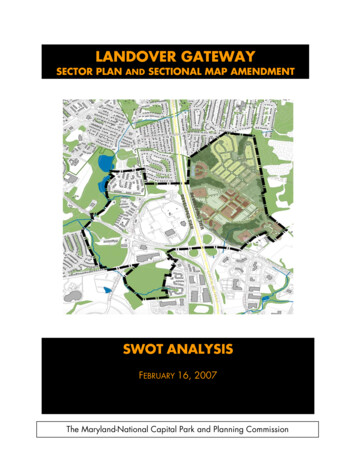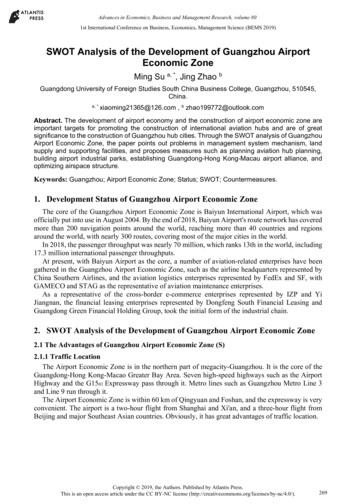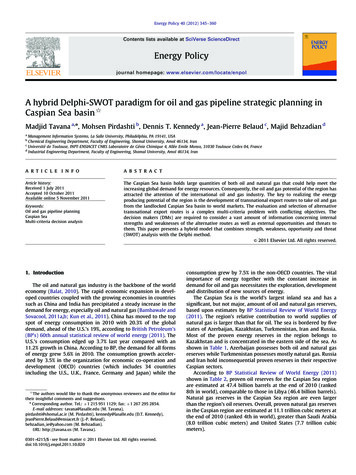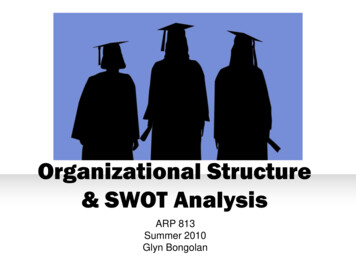
Transcription
How to Conduct ASWOT AnalysisDr. E. J. KeeleyExecutive Director, Institutional Effectivenessand Research1
Purpose To provide an overview of environmentalscanning and SWOT analysisTo develop an understanding of the process ofconducting these activities in your unitTo develop an understanding of when and howthese processes should be conductedTo develop an understanding of how toincorporate results of these analyses into youraction plan2
Training Agenda Overview of Institutional EffectivenessOverview of the strategic planning process andits connection to environmental scanning andSWOTEnvironmental ScanningSWOT AnalysisRecording analysis resultsWrap-Up3
Role of Institutional Effectiveness Institutional Effectiveness is the ongoing questfor quality and the demonstration of how wellEKU is fulfilling its mission, realizing its vision,and implementing its strategic plan.6 components of Institutional Effectiveness toachieve continuous improvement and qualityenhancement.Handouts:Framework Calendar of Activities 4
Strategic Planning Process5
Environmental Scanning (ES) is The process of taking stock and involvesthorough examination of both the internal statusof the organization and the external context inwhich it is situatedA method that enables decision makers both tounderstand the external environment and theinterconnections of its various sectors and totranslate this understanding into the institution’splanning and decision-making processes6
Environmental Scanning (ES) is A kind of radar to scan the world systematicallyand signal the new, the unexpected, the majorand the minorThe exploration phase of a strategic planningprocess. Scanning is our opportunity to take afresh, objective look at educational needsThe process of using information about theworld in decision making.7
Principles of ES Explore both sides of the ledger to gain acomplete pictureThink macro and microUse multiple lenses to look at the sameinformation or situationLook for ways to triangulate informationThink beyond felt needs and opportunities8
3 Levels of Environment Task Environment: The institution’s set of clients or customers. In higher education, this may include students, potential students,parents, political leaders, and employers.Industry Environment: Comprises all enterprises associated with an organization insociety. For higher education, public confidence or student aid legislation areindustry factors affecting institutions.How will these groups impact the organization in the future?9
3 Levels of Environment Macroenvironment: Social/demographic/cultural What is the dominant religion? Technological/scientific Does technology offer our unit a new way to communicate with ourclients? Economic/occupational Interest rates Environmental Does the population have a strong/weak opinion on green issues? Political How stable is the political environment?10
Scanning Passive Scanning:Reading journals/newspapers. Passive scanning doesnot use a systematic process for scanning theinformation. Consequence: potential to miss ideas that signalchanges in the environment. Active Scanning: Focuses attention on information resources thatspan the task, industry, and macroenvironment.11
Environmental Scanning Process Identify who is responsible for the process Determine the appropriate data collectionmethods and a plan for scanning Committee of people, with fair representationWho will be responsible for what, by when?Review and update socioeconomic andcounty/area informationTake stock of existing in-house information12
Environmental Scanning Process Actively collect and assess scanning informationSurvey key leaders in organization for critical trendsand developments affecting the institution Conduct interviews/focus groups with internal andexternal constituents Compare this information with benchmarkingefforts, self-studies, or the existing strategic plan 13
Environmental Scanning Process Initiate a series of exercises where the“environmental scanning group” identifies andprioritizes critical trends and emerging issues in theenvironment Data to come from any of the identified methods Instruct participants to: Seek signs of changeLook for signals of potential events on the horizonLook for forecasts of expertsLook for indirect effectsBe aware that there are few guidelines on how to do scanningWrite a summary14
Environmental Scanning Process Synthesize and act on scanning information: Translate scanning information into actionable ideas. How? Conduct a SWOT Analysis15
EKU Process for EnvironmentalScanning Define environmental scan/purposeIdentify data needs that would guide future planningIdentify who has the data sourcesContact those with data to identify what is available andplace requestsGather DataOrganize data sets into big chunksDisseminate data sets to individuals or small groups toreview/analyze16
EKU Process for EnvironmentalScanning Individuals/small groups submit up to one pagesummary of data reviewedLeaders of the group compile all summaries intofinal environmental scanning report andpresentation to large groupLeaders get final approval of both productsfrom scanning groupInformation to be used by the Strategic PlanningCommittee as they develop the next iteration ofthe EKU strategic plan17
Data Collection MethodsSurveysFocus Groups/InterviewsOpen Forums/PublicMeetingsObservation/site visitsMedia MonitoringAnecdotes/Case studiesLiterature Reviews18
When Do I conduct anEnvironmental Scan & How Often?Environmental Scanning process should beCONTINUOUS! Develop a plan for how this process will befollowed-through on a regular basis. Conduct an annual formal review to inform theongoing strategic planning process.19
Strategic Planning Process20
What is a SWOTAnalysis?21
SWOT Analysis is A tool for auditing an organization and its environmentFirst stage of planning; helps to focus on key issuesRole of SWOT is to take the information from theenvironmental scan and separate it into internal andexternal issues.Once this is completed, SWOT determines if theinformation indicates something that will assist theorganization in accomplishing its objectives or if itindicates an obstacle that must be overcome orminimized to achieve desired results22
SWOT standsforStrengths, Weaknesses,Opportunities and Threats23
Strengths Strengths—internal to the unit; are a unit’s resources and capabilities that can beused as a basis for developing a competitive advantage; strengths should berealistic and not modest. Your list of strengths should be able to answer: What are the unit’s advantages?What does the unit do well?What relevant resources do you have access to?What do other people see as your strengths?What would you want to boast about to someone who knows nothing about thisorganization and its work? Examples: good reputation among customers, resources, assets, people,experience, knowledge, data, capabilities Think in terms of: capabilities; competitive advantages; resources, assets, people(experience, knowledge); marketing; quality; location; accreditations,qualifications, certifications; processes/systems24
Weaknesses Weaknesses—internal force that could serve as a barrier to maintain or achievea competitive advantage; a limitation, fault or defect of the unit; weaknessesshould be truthful so that they may be overcome as quickly as possible. Your list of weaknesses should be able to answer: What can be improved?What is done poorly?What should be avoided?What are you doing as an organization that you feel could be done moreeffectively/efficiently?What is this organization NOT doing that you feel it should be doing?If you could change 1 thing that would help this department function more effectively,what would you change? Examples: gaps in capabilities, financial, deadlines, morale Think in terms of: disadvantages; gaps in capabilities; lack of competitivestrength; reputation; financial; timescales/deadlines; morale/leadership;accreditations; process/systems25
Opportunities Opportunities—any favorable situation present now or in thefuture in the external environment. See Environmental Scan, STEEP Analysis Data Examples: unfulfilled customer need, arrival of newtechnologies, loosening of regulations, global influences,economic boom, demographic shift Where are the good opportunities facing you?What are the interesting trends you are aware of?Think in terms of: market developments; competitorvulnerabilities; industry/lifestyle trends;; geographical;partnerships26
Threats Threats—External force that could inhibit the maintenance or attainment of acompetitive advantage; any unfavorable situation in the external environmentthat is potentially damaging now or in the future. See Environmental Scan, STEEP data Examples: shifts in consumer tastes, new regulations, political or legislativeeffects, environmental effects, new technology, loss of key staff, economicdownturn, demographic shifts, competitor intent; market demands; sustaininginternal capability; insurmountable weaknesses; financial backing Your list of threats should be able to answer: What obstacles do you face?What is your competition doing?Are the required specifications for your job/services changing?Is changing technology threatening your position?Do you have financial problems?Could any of your weaknesses seriously threaten your unit?27
Benefits of SWOT Analysis ScaleableSimplicityLow 28
Who should be involved in theSWOT? Conduct Focus Group Sessions; planningmeetings Internal and external constituents to develop listof strengths, weaknesses, opportunities, threats Planning committee to develop/select/incorporate strategies into strategic plan29
Steps toConducting a SWOT Analysis1.2.3.4.5.6.7.8.9.10.Driving Forces (Environmental Scan data is presented)Generate list of Strengths, Weaknesses, Opportunities,ThreatsClarification of SWOTsCategorization into themesPrioritizationDesired State & Implications to unitStrategy DevelopmentStrategy SelectionIncorporation of strategies into Strategic PlanDocumentation30
Prioritization Reduce generated list to top 5 ideas per categoryHow to prioritize?Strengths that are distinctive competencies Weaknesses that are debilitating Reducing threats and maximizing opportunities Use a Prioritization Matrix31
Identifying xploreExploitAvoidConfront32
Criteria for formulating and adoptingstrategies and plans: Acceptability of decision makers, stakeholders,consumersUser impactRelevanceConsistency with vision, mission, and valuesIntegration/coordination with other strategies,programs, and activitiesTechnical feasibilityCost feasibility33
Criteria for formulating and adoptingstrategies and plans: Cost effectivenessLong-term impactRisk assessmentStaff requirementsFlexibility/adaptabilityTimingFacility requirementsTraining requirements34
Selecting Strategies See: Selection Grid Handouts35
Recording Results The results of your environmental scan shouldbe incorporated in your group’s strategic planunder the section “Environmental Scan”Two categories of information should beentered: external trends (Opportunities, Threats)and internal trends (Strengths, Weaknesses)Type this information manually into the planonce you have saved the document fromTracDat.36
Thank You!37
SWOT AnalysisSWOT Analysis Recording analysis resultsRecording analysis results WrapWrap--UpUp. 4 Role of Institutional Effectiveness Institutional Effectiveness is the ongoing quest Institutional Effectiveness is the ongoing quest for quality and the demonstration of how well for quality and the demonstration of how well EKU is fulfilling its mission, realizing its vision, EKU is fulfilling .
